In a
future blog post, I will detail the travails that Emmelle and I experienced to get to Seoul and ultimately Tokyo. And at the epicenter of this harrowing trip? One sushi dinner at Sukiyabashi Jiro. Yes, we did watch the documentary Jiro Dreams of Sushi and felt overwhelmingly compelled to make an effort to eat there. Without intention of sounding crass, we aimed to dine at the three-Michelen star rated Ginza location, with the eightysomething-year old Jiro Ono at the healm, before he retired, became ill or worse.
Our
hotel concierge helped make a reservation prior to our flight, but we were only able
to secure seating at the second brother’s (Takashi) sister
restaurant in posh Roppongi Hills. The Roppongi Hills location boasts a cheaper price tag but
is by no means a value meal. Let’s get one thing straight. This meal was not worth
the money. And as much as I love food and a memorable dining experience, I don’t
think any meal (of any caliber) is worth this much dough. However, as the wise Emmelle reminded
me after our dinner, its worth what you are willing to pay…and we were willing to
pay. Lessons of a free market system.
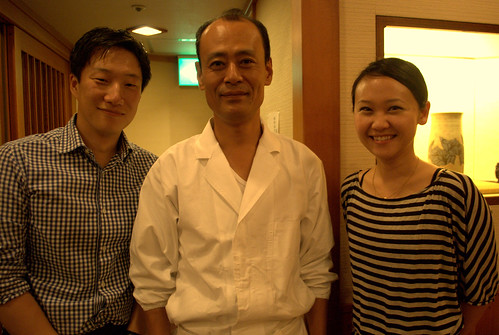
The Roppongi Hills location is a bit difficult to find, and I would not have been able to
identify the establishment if I had not seen photographs of the entrance way from
other blogs (no signs in English). We entered hesitantly but were greeted warmly by the hostess and immediately seated.
The restaurant offers bar seating exclusively, and on this night, we counted nine total seats. To our far left, an English speaking pair. The seats adjacent to me were empty when we sat down but would soon be occupied by two Americans. To the right of Emmelle sat a Japanese family of three. They were winding down their meal (we watched the chef serve them the eel and egg courses to finish). The Japanese family included a small boy, he couldn't have been older than 12 years old, eating one of the most expensive sushi meals in the world. I felt poor. Later another family threesome from England came in to take the vacant seats. Again, a child in the midst eating enjoyably and rating the food quality. I felt uncultured.
The head chef, Takashi Ono, and his sous chef (English speaking) stand opposite the bar, facing the patrons with their impeccably clean work stations serving as the divide. There is a wooden panel in front of your eating area, so you have to sit upright a bit to get a good view of the chefs' work. All eyes (sans the Americans on the far left, more on them in a bit) descend upon chef Takashi - his deft knife work, economic and effortless motions - years of honing and perfecting realized right before our eyes. Chef Ono has a pleasant disposition and kind eyes but in this place, he is a divine emperor, a sushi demigod. His presence shines brightly in the unassuming establishment.
He shares a few jokes with the Japanese family. I feel as though they are remarks about the foreigners that have invaded his restaurant. It's true though; his restaurant offers an easier reservation than his father's Ginza location. And once the Japanese family completed their meal, the whole restaurant would be filled with foreign travelers. I wonder how he feels about this evolution to his business.
The sous
chef asked if we’d like to start with sashimi; we elected to dive in to the
sushi pieces right away. In order:
Hirame(flounder)
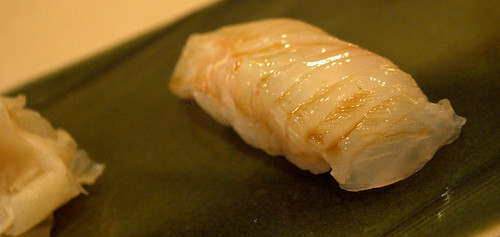
Pretty straightforward, but immediately both Emmelle and I notice the wonderful vinegary sushi rice. A foodie would probably begin to describe it as complex and so forth. I can tell you that it tasted good. Real good. Fresh grated wasabi, smeared between the fish and rice is present but not a prominent taste in the overall experience.
Ika (squid)

Creamy, chewy, delightful.
At this point in the evening, we couldn't help but notice the Asian-American woman to our far left. Actually, it was impossible not to notice her. In this small, tranquil environment, this woman spoke to her dinner partner as if they were a room apart. This went on for the entire hour. The entire restaurant listened to her inane dinner conversation. I waited patiently for the chef to admonish her with a stern look or even better, slap her with a piece of fish.
It never happened.
Maguro(tuna)
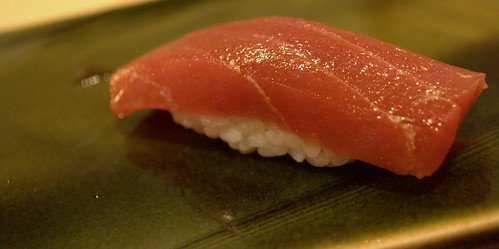
Sukiyabashi Jiro's marinates their tuna in soy sauce (and maybe with sake as well) to bring out a nice flavor in the fish. If tuna held this much flavor at our local sushi restaurants in the United States, I would order it on occasion. To date, I've had some of the best maguro in Hawaii. The tuna at Jiro's was excellent as well.
Chu-toro(medium fatty tuna)
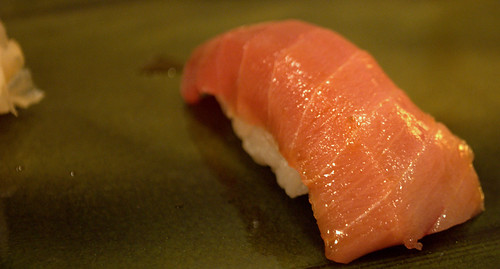
This might have been our favorite piece of the night. More flavorful than maguro but not as rich as the fatty tuna piece served right after. I've had chu-toro at a couple of nice Japanese restaurants in SF and NY - I've never been disappointed and is usually a must-order if it's on the menu.
O-toro(fatty tuna)
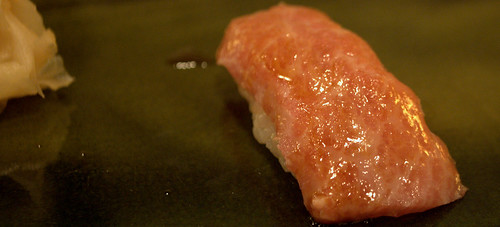
I've never had fatty tuna quite like this. Even the marbled flesh alone is perhaps worth its own blog post. It looks like kobe beef. The taste? Quite remarkable and completely melts in your mouth. Again, never had a sensation like this in the past.
Kohada(shad gizzard)

A form of sardine, we've been enjoying kohada at reputable Japanese restaurants for the past couple of years. It's actually in-season now and found in many Korean homes and restaurants as well. Jiro's actually pickles the fish. While delicious with this preparation, I actually prefer it without the pickling which slightly masks the naturally nutty flavor. I can have my own opinion, right?
Awabi(steamed abalone)
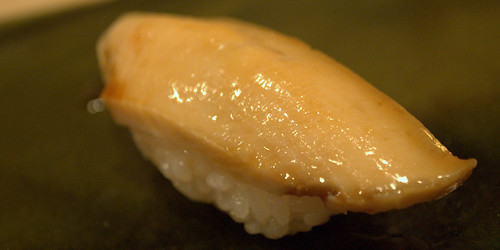
I heart abalone but am not a big fan of any cooked (grilled) preparation. However, this was steamed perfectly, accentuating the natural sweetness of the meat. This was the first cooked dish presented. With those, chef Takashi Jiro would say "still warm". We quickly learned that to mean, "put this in your mouth immediately."
Meanwhile, our favorite Asian-American woman is yelling at her friend about how delicious the kobe beef is at Alexander's steakhouse. Oh dear, she lives or has spent time in the Bay Area. We try not to make eye contact. Her friend was probably deaf by the end of the night.
The pair sitting directly to my left decide to skip the fatty tuna course. Why the heck did they come?
Kuruma-ebi(Japanese tiger shrimp)

If you've seen the documentary, the narration includes a bit about the ebi and mentions that the cooking process retains the flavor of the shrimp head (the best part by anyone's estimation). Yes, they do get a good piece of the head goo when they peel the cooked piece. And yes, it's a well-cooked piece of shrimp. But...I'd always rather have raw shrimp. These tiger shrimp are huge, couldn't we just sample the raw flesh? I can have my own opinion, right?
Interestingly, chef Ono serves this dish differently for male and female patrons. He keeps the tail on for men while cutting it off for women. I had to ask if I should eat the tail. The sous chef politely tells me not to while taking a mental note that he was serving a true sushi novice. I would disagree with his rude assertion, but if he told me to eat it, I would have. If he told me at the beginning of the meal to slam my forehead repeatedly on the sushi bar, I would have done so. The power these guys yield...we should all be in that much control in our respective work places.
Back to the tails though. It turns out it's just a table manner thing. They don't want the women to have to savagely rip the tails off and put the bitten ends back on their plates. I don't think this is so terrible but I'm sure there are feminists that would object - it's their choice.
Ikura(salmon roe)
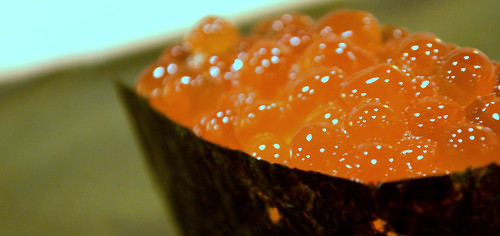
All fishiness completely dissolved away by the sake marinade. Quite enjoyable and tasted like a great deal of care went into preparing this bite.
When the sous chef rolled the rice for chef Ono, the head chef turned to him and clearly reprimanded him in Japanese for an oversight / mistake. The sous chef looked down nervously at his work station and quietly accepted the verbal punishment. A restaurant full of foreigners certainly has its advantages; the chef was free to turn our dinner course into a teaching lesson. The chastisement would continue through the night at both the sous chef and some of the kitchen apprentices.
Akagai(ark shell clam)
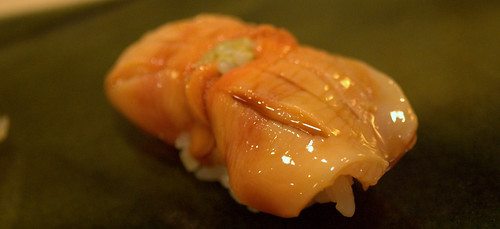
I actually squealed a little bit when I bit into this piece. I am a big fan of mirugai, so naturally, I would also enjoy its mollusk cousin. Both the chef and sous chef looked up from their work, startled at my short yelp. They quickly turned back towards their craft when they realized it was nothing more than a gasp of pleasure. The texture of clam is what I really like. You can almost hear the crunch in your mouth as you break down the fibers. I will always order this if I see this on an American sushi menu (I never have though).
Uni(sea urchin roe)
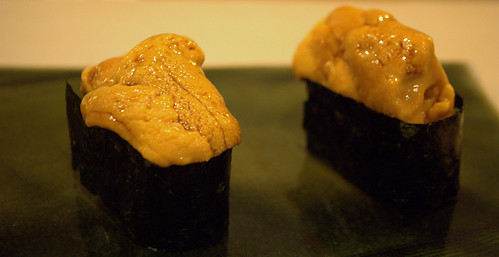
Apparently, the sous chef misheard us when we told him that Emmelle has an uni allergy. I watched the chef prepare our sushi pieces hoping that the two he was preparing would go to other patrons. When he plated them, I politely reminded the sous chef of her allergy. He meekly translated the news into Japanese, and the chef sighed an air of annoyance while simply moving Emmelle's piece onto my dish. All of the diners laughed. What a comedian! The sous chef appeared as though he would weep into the sushi rice.
Rich and velvety, delicate, incredibly sweet and piled high. Looking back now, I can't imagine eating just one. I think these are sourced from Hokaido. I've had a similarly wonderful uni experience with fresh Santa Barbara ones.
Mirugai (giant clam)
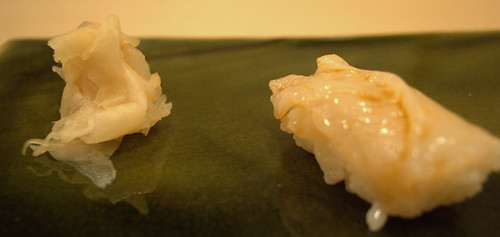
Delicious, yes. But nothing overwhelmingly different from what we can get in California.
Saba(mackerel)
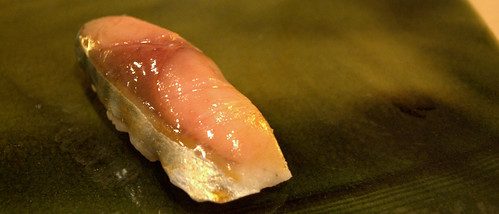
Saba always comes down to the sake marinade. This was quite pleasant and beautiful to look at. I'm reminded of sushi boats and all-you-can eat buffets where mackerel pieces are an off white to dull yellow color. Yikes.
Hotate(scallops)
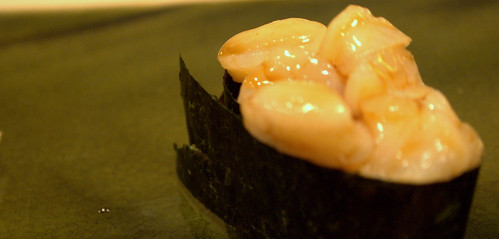
Going back to that enjoyable crunch of fresh clams, we were pleasantly surprised to find a similar texture with the small scallops. We both agreed that we'd never had scallops with such texture before. All scallops should be like this.
Bonito(bonito tuna)
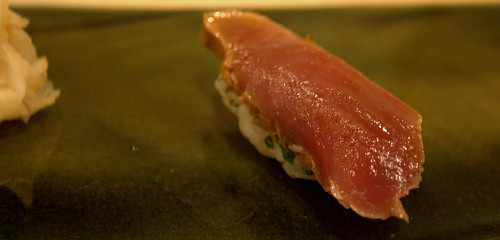
We Americans see bonito more commonly in the bonito fish flakes used to top various Japanese dishes. This fish is smoked so actually tasted like a nice piece of jerky. "Campfire" according to Emmelle.
Unagi(sea eel)

The first of two sweet dishes to complete the meal. To this day, the best unagi we've ever had was at Sebo in San Francisco. Rather than use the common sweet glaze, Sebo applied nothing more than sea salt. We couldn't find this dish in subsequent visits.
Tamago(egg)
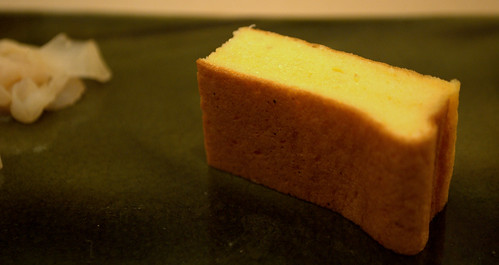
Wonderful way to finish a sea of raw fish in your belly. This was basically an egg custard, so soft, sweet and delicate. My tamago piece is pictured above. Emmelle's piece, and those of other women, are cut in half. The chef asks if you'd like to have it served as nigiri with rice on top.
Regrettably, I forgot to take a picture of the Aji(horse mackerel) we had, and I can't recall where it came in the course. It was great like everything else, but without a photograph, I feel like we didn't eat it at all.
Also, where was the tako?! We were looking forward to the massaged octopus. It wasn't in the cards on this night.
The meal actually lasted a little over an hour. After having watched the documentary, my main concern was how quickly the meal would end - 20 min? 30 min if we were lucky? No, the chef paced the meal very well. If he had waited longer than he did in between pieces, I'm sure we would have been much too full to finish the course. And there is trust between patron and chef that when he puts his finished craft on your plate, it's the right moment to eat it. Ultimately, the entire establishment reaches a harmonious rhythm. The chef places a piece of sushi on your plate, you put it in your mouth, as you chew (after you have already gasped a little and rolled your eyes back) you watch him put together and plate pieces for those around you. On and on this goes.
Before we get up to pay, the sushi chef asks us where we are from. When we say San Francisco, the annoying woman on our left becomes interested. We continue to try to ignore her and are surprised to find the sous chef asking if we've seen the documentary. This quickly leads to chef Takashi Ono offering himself for a group picture. What a guy! The loud mouth woman is now accutely aware that this restaurant is of some sort of acclaim (why the heck did she come?) and asks who the owner is. She sees us snap photos with the chef and now must take a couple herself. We leave, but not before Takashi (I'm on first name basis now) stops us at the door to offer us his business card (Biz cards are a big deal in Japan we learned in our travel guide). I didn't have one to offer as the chief writer and editor of GreensandBrowns, but perhaps he recognized me? We'll never know, but its probably safe to assume yes.
A parting thought. I'm pretty sure I'll never eat here again. Even if we were to come back to this great city, I'd like to venture to other establishments to compare. But I don't think I'll be missing out on a great deal. Throughout the meal and then afterwards in my dinner debrief with Emmelle, I couldn't help but think that the sushi we eat in the United States at more reputable (expensive) places, are actually doing a great job. Many of the sushi pieces reminded me of flavors I've had before at places in the Bay Area such as Sebo, Sushi Ran or even less stuffy places like Ryoko in downtown SF.
And now more than ever, it seems like sushi restaurants with the resources to import fish from Japan and the famed Tsukiji fish market in Tokyo, are actually doing so. The
meal definitely validated my belief that our favorite Bay Area places are more than holding their own. The big difference? A place like Sukiyabashi Jiro treats the cuisine as a true art form and expects their diners to recognize it with the same reverence. Is that silly? I would say "most of the time, yes". Even still, the meal was an indelible experience, one of the more sophisticated dinners we've had. I'll remember it fondly, especially as I look at the a la carte menu at my favorite sushi spots in the US.
Thanks for stopping by.
|

